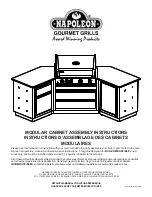
English
8
also charge a partially used pack whenever you desire
with no adverse effect on the battery pack.
5. Foreign materials of a conductive nature such as, but
not limited to, grinding dust, metal chips, steel wool,
aluminum foil, or any buildup of metallic particles
should be kept away from charger cavities. Always
unplug the charger from the power supply when there
is no battery pack in the cavity. Unplug the charger
before attempting to clean.
6. Do not freeze or immerse the charger in water or any
other liquid.
Storage Recommendations
1. The best storage place is one that is cool and dry, away
from direct sunlight and excess heat or cold.
2. For long storage, it is recommended to store a fully
charged battery pack in a cool dry place out of the
charger for optimal results.
nOTE:
Battery packs should not be stored completely
depleted of charge. The battery pack will need to be
recharged before use.
SAVE THESE INSTRUCTIONS FOR
FUTURE USE
Intended Use
These drills/drivers/hammerdrills are designed
for professional drilling, percussion drilling and
screwdriving applications.
DO nOT
use under wet conditions or in presence of
flammable liquids or gases.
These drills/drivers/hammerdrills are professional
power tools.
DO nOT
let children come into contact with the tool.
Supervision is required when inexperienced operators use
this tool.
Variable Speed Trigger Switch (Fig. A)
To turn the tool on, squeeze the trigger switch
1
. To turn
the tool off, release the trigger switch. Your tool is equipped
with a brake. The chuck will stop as soon as the trigger
switch is fully released.
nOTE:
Continuous use in variable speed range is not
recommended. It may damage the switch and should
be avoided.
Side Handle (Fig. A)
WARNING:
To reduce the risk of personal injury,
ALWAYS
operate the tool with the side handle
properly installed. Failure to do so may result in
the side handle slipping during tool operation and
subsequent loss of control. Hold tool with both hands
to maximize control.
Side handle
10
clamps to the front of the gear case and
may be rotated 360° to permit right- or left-hand use. Side
handle must be tightened sufficiently to resist the twisting
action of the tool if the accessory binds or stalls. Be sure to
grip the side handle at the far end to control the tool
during a stall.
Forward/Reverse Control Button (Fig. A)
A forward/reverse control button
4
determines the
direction of the tool and also serves as a lock-off button.
To select forward rotation, release the trigger switch and
depress the for ward/re verse control button on the right side
of the tool.
To select reverse, release the trigger switch and depress the
forward/reverse control button on the left side of the tool.
The center position of the control button locks the tool in
the off position. When changing the position of the control
button, be sure the trigger is released.
nOTE:
The first time the tool is run after changing the
direction of rotation, you may hear a click on start up. This is
normal and does not indicate a problem.
Torque Adjustment Collar (Fig. C–E)
Your tool has an electronic adjustable torque screwdriver
system for driving and removing a wide array of fasteners.
Circling the torque adjustment collar
5
are numbers, a drill
bit symbol, and in some models, a hammer symbol. These
numbers are used to set the tool to deliver a torque range.
The higher the number on the collar, the higher the torque
and the larger the fastener that can be driven. To select any
of the numbers, rotate until the desired number aligns with
the arrow.
WARNING:
When the torque adjustment collar is
in the drill or hammerdrill positions, the drill will not
clutch. The drill may stall if overloaded, causing a
sudden twist.
Fig. C
Fig. D
5
6











































